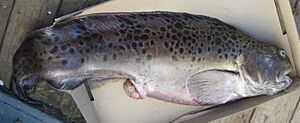Spotted wolffish facts for kids
Quick facts for kids Spotted wolffish |
|
|---|---|
 |
|
| A spotted wolffish caught near Upernavik Kujalleq, Greenland | |
| Conservation status | |
|
Invalid status (NatureServe)
|
|
| Scientific classification | |
| Synonyms | |
|
The spotted wolffish (Anarhichas minor) is a large fish that lives in the ocean. People also call it the spotted sea cat or leopardfish. It belongs to the Anarhichadidae family of fish. This amazing fish lives on the ocean floor.
You can find spotted wolffish across the North Atlantic Ocean. They also live in nearby parts of the Arctic Ocean. Their home stretches from northern Russia and the Scandinavian Peninsula all the way to Nova Scotia, Canada. Sadly, the number of these fish in Canada dropped by about 90% between the late 1970s and early 1990s. Because of this, Canada lists it as a threatened species.
Contents
What is a Spotted Wolffish?
Spotted wolffish have strong, canine-like teeth at the front of both jaws. They have a heavy head with a rounded snout and small eyes. Their body is long and strong, but they do not have pelvic fins. A long dorsal fin runs along their back, almost to their tail. They also have flexible, spiny rays and small, rounded tail fins. Their pectoral fins are rounded too.
Their colors can change from pale olive to deep brown. The upper parts of their body have many blackish-brown spots that are not perfectly shaped. These fish can grow very long, over 1.8 meters (6 feet). They can also weigh up to 23 kilograms (50 pounds).
How to Tell Them Apart
You can easily tell the spotted wolffish apart from other wolffish species. The northern wolffish (A. denticulatus) and Atlantic wolffish (A. lupus) do not have the dark spots. These spots are a key feature of the spotted wolffish.
Where Do Spotted Wolffish Live?
Spotted wolffish live in the Arctic Ocean. They are also found on both sides of the North Atlantic Ocean. Their range goes from Labrador in Canada to the Barents Sea in Europe. In Canada, they are sometimes seen as far north as Baffin Bay.
In the western North Atlantic, you can find them near east and west Greenland. They also live on the Labrador Shelf and Grand Banks. They are less common on the Scotian Shelf. Sometimes, these fish are caught as far south as Scotland and Ireland.
Habitat and Life Cycle
These fish prefer cold, deep ocean water. They usually live in water colder than 5°C (41°F). Their depth ranges from 50 to 800 meters (164 to 2,625 feet). However, in the Canadian Arctic, they can be found as shallow as 25 meters (82 feet).
Spotted wolffish like bottoms made of coarse sand or sand mixed with shells. They also need rocky areas nearby. These rocky spots provide shelter and places to build nests.
Reproduction
Spawning, which is when fish lay eggs, happens from summer to late fall or early winter. The female fish lay up to 54,600 large eggs. These eggs can be up to 6 millimeters (0.24 inches) wide. They lay them in deep water in clusters on the sea floor. The male wolffish primarily guard these eggs.
Spotted wolffish grow slower than the Atlantic and northern wolffish. They become mature and can reproduce when they are seven years old or older. These fish can live for up to 21 years. They do not swim in large groups or travel far. Their movements are usually local and limited.
What Do Spotted Wolffish Eat?
Spotted wolffish mostly eat hard-shelled animals found on the ocean bottom. These include crustaceans like crabs, mollusks like clams, and echinoderms like sea urchins. Their diet also includes other fish species. They will even eat eggs and larvae from other fish that lay their eggs in nests. Sometimes, they have been seen eating other wolffish.
Protecting Spotted Wolffish
The Committee on the Status of Endangered Wildlife in Canada (COSEWIC) has said that this species is threatened. It is protected under Canada's federal Species at Risk Act since June 2004. In Europe, the IUCN (International Union for Conservation of Nature) lists it as Near Threatened. This means it could become threatened in the future.
Threats to Their Survival
Scientists believe that too much Overfishing and changes to their habitat have caused the number of wolffish to drop. In Canadian waters, people do not specifically fish for spotted wolffish. However, they are often caught by accident. This happens when large trawlers and long-liners fish for other species. This accidental catching, called bycatch, is a big threat.
Also, activities that disturb the ocean bottom can harm their homes. For example, trawling can damage the places where they lay their eggs. Protecting their habitat and reducing accidental catches are important steps to help these unique fish.


